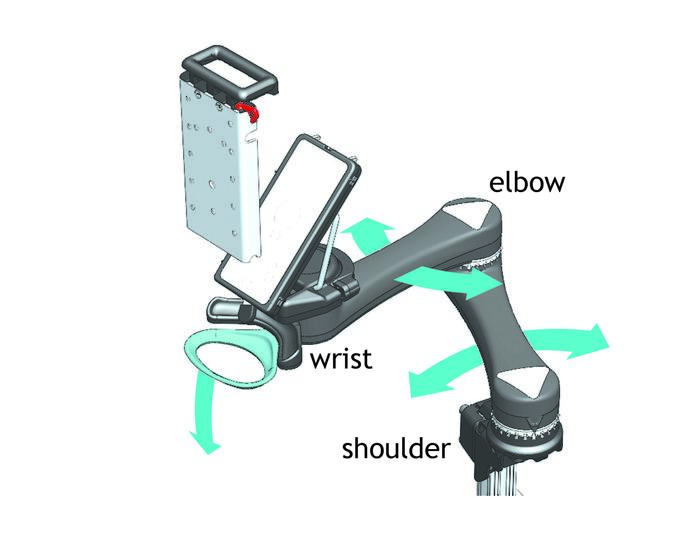
When looking to position technology on a wheelchair, sometimes the decision around which mount to choose can be quite overwhelming. There are many different styles with varying functions and sometimes it’s hard to know where to start.
Answering a few simple questions can assist you and your support team to begin the decision-making process and help determine which mounting options might suit you best.
We have broken them down into “feature focused” questions to digest easily and is nothing more than the same type of “features vs need” matching pathway that was most likely used to choose the technology being mounted.
Consider the technology you are mounting onto a wheelchair.
Is it small and/or lightweight?

Lightweight devices such as an iPad, tablets or smaller speech generating device can be supported by mounts with much smaller tubing.
This includes the DAESSY LITE or DAESSY MINI ranges of mounts. The DAESSY LITE mount is able to position devices up to 1.5kg and DAESSY MINI up to 4kg.
Is it larger/heavy eye-gaze access technology?
The DAESSY STANDARD mounts with larger tubing are most suitable for those people using technology that is heavier than 4kg in total weight.
You may also want to consider DAESSY STANDARD mounts if your device needs greater stability. This may include the use of eye-gaze devices where the mount has a long vertical pole. If the person using the technology has movement or if they will be propelling their wheelchair over bumpy terrain this can translate to “bumping” of the mounted technology. In this instance the STANDARD mounts provide a little more stability and dampening than the MINI range.
Consider the functionalities you require
Do you need a simple removable mount that is easy for a variety of carers to use?
These are all questions that need to be explored with the person using the technology and their support team.
For some people, a simple mount to support technology is required that attaches to the wheelchair and can be removed as required.

This is often important for people when a number of carers are involved and simplicity is needed.
Mounts of this type include the DAESSY Rigid Mounts, either the Bent-tube variant (as seen above in the Mini Bent-tube kit) for simplicity or regular DAESSY Rigid Mounts if vertical tubes with offset bend are needed (see Fitting A Mount Kit – Part 2)
Do you need a mount that folds for transfers or storage?
Other people may require a mount that folds or swings to the side to avoid having to remove the mount for transfers or when wanting the device / mount out of the way for other activities.
In particular, Folding Mounts can also be “folded” to a more compact form for storage or transporting in a bag.

NOTE: A risk assessment is required before folding a mount with an attached device to the side of the wheelchair. The weight and position of the technology and the mount out to the side of the wheelchair and puts technology at risk of damage. It is not recommended to have a device folded to the side of a manual wheelchair when it is vacated for transfers.
In both instances above, the device and mount should be removed prior to the transfer.
Do you need to be able to move the mount away yourself for transfers?
For other people using technology, it is important to be able to independently move the mount and device out of the way themselves.
This may be required for those who are living independently and need to be able to move the mount away for transfers or for people who need to regularly access other equipment, for example, a classroom desk.

These types of mounts do require some level of functional upper limb use. Examples include the DAESSY Swing Away Mount, the Mount’n Mover or Easy Mover mounts.
Do you access your device in different ways and need flexibility in the mounting position?
Some people require a mount that provides flexibility in its position. This might be important for someone whose position changes a lot from day to day or for those people who are using different access options.
A person may need their device positioned mostly for direct access but when fatigued may need the device raised for eye gaze access. Or someone with a degenerative condition may be using direct access initially but may need to be using eye gaze in the future and want flexibility in their mount to accommodate this change.

In this instance, an adjustable mount such as the DAESSY Positioner Mount or DAESSY Mini Adjustable Mount mounts could be considered.
Consider Your Wheelchair
Along with choosing the most suitable features of a mount to best suit your needs you also need to consider the features of your wheelchair and technology.
This includes exploring where might be the best place to secure the mount on your wheelchair, if the mount needs to be transferred between different wheelchairs and how the technology will attach to the mounting system. See our “Fitting A Mount Kit” series of articles for further details.
Please feel free to contact Communicate AT to further discuss options for yourself or someone you are supporting to position technology on their wheelchairs.

